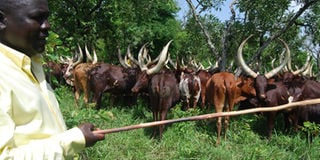Prime
‘My cows give me 200 litres of milk daily’

Brig Otema with his cattle at his farm. PHOTO BY CISSY MAKUMBI
What you need to know:
He is an army general on the regular. But on his days off, he goes to the farm. He told Cissy Makumbi about his interest in farming.
My name is Charles Otema Awany, 52, a cattle farmer in Katinya village, Purongo Sub-county in Nwoya District.
I am a Brigadier in Uganda People’s Defence Forces, where I am the Chief of Engineering and Logistics based at Bombo barracks.
I started in 2007 with 100 head of cattle, which I bought at Shs600,000 each. Now, I have 1,000 and plan to have 4,000. The farm has the capacity for that number, and I hope it will be that in the future.
I used my savings to buy the first animals. That is why I could not procure many at once since the animals also need regular monitoring.
The business
I have the Ankole long-horned cattle that I was introduced to when I was in charge of the 2nd Division in Mbarara. Since then I got determined to keep this particular breed. Today, I have a reason to smile.
Every day, from the cows, I get at least 200 litres of milk which I sell to traders and individual customers in Nwoya and Gulu districts.
I am planning on getting a cooler to preserve the milk and reduce the spoilage.
Currently, the milk is sold locally within those area. But I hope as time goes on, I will acquire the technology to enable me package the milk and export it to the neighbouring countries.
Also, every month, from the cows I get 50 calves. When they reach one year, I sell each one at Shs1m. I also sell some of the bulls at Shs500,000 each.
Some of those who buy the bulls get them for animal traction in opening land for cultivation. Usualy, the farmer would use four oxen but with the Ankole bulls, it is only two.
I am also looking forward to having cattle that will be kept for specifically beef. I intend to exploit the market for that too.
Though this market for beef is available even within the region itself. I expect to tap the one in South Sudan as well.
Management
I have more than 60 employees and I spend about Shs6m every month to pay them. I also have a veterinarian at hand to cater for the animals. In case there is any outbreak of any disease, he responds immediately.
As regards day-to-day management, I strike a balance between my office work at Bombo and my farm work.
The time I get off work, I go to the farm. In cases that I am not able to, there is a farm manager who is always available.
Challenges
Just like any other investment, looking after animal requires close monitoring. At times, the workers also steal the animals. Since I started the venture, 100 animals have gone missing. I managed to get the culprits and take them to court.
Another challenge was when I started, the area was infested with tsetse flies. I overcame that with the advice and services of technical people.
Aside from the challenges, there are opportunities for fieldwork or learning on the farm.
There are students who have visited the farm, some came from Kawanda while others came from Bobi Polytechnic. Also, I approached Gulu University administration to have their students visit the farm for study tours. I hope they will buy the idea.
I do not charge those who come. Skills are free. We are looking at transforming the society.
Characteristics of the Ankole longhorn
The Ankole Longhorn belongs to the Sanga group of cattle. It is indigenous to central and eastern Africa. In Uganda, it is found in western and south-western parts.
Classified as an intermediate Bos indicus (lateral horned Zebu) and Bos taurus (Hamitic longhorn) breed type with a small hump, it has a relatively large body frame and characteristically long, large horns.
The Ugandan population size is unofficially estimated to be 2.9 million. The Ankole Longhorns, having been developed mainly through natural selection, have the ability to survive and reproduce under the climatic stresses.
Traditional cattle production is based on pastoral grazing without supplementary feeding or regular water availability. This has enabled cattle keepers to utilise this genetic resource under a low input production environment for food and agriculture.




